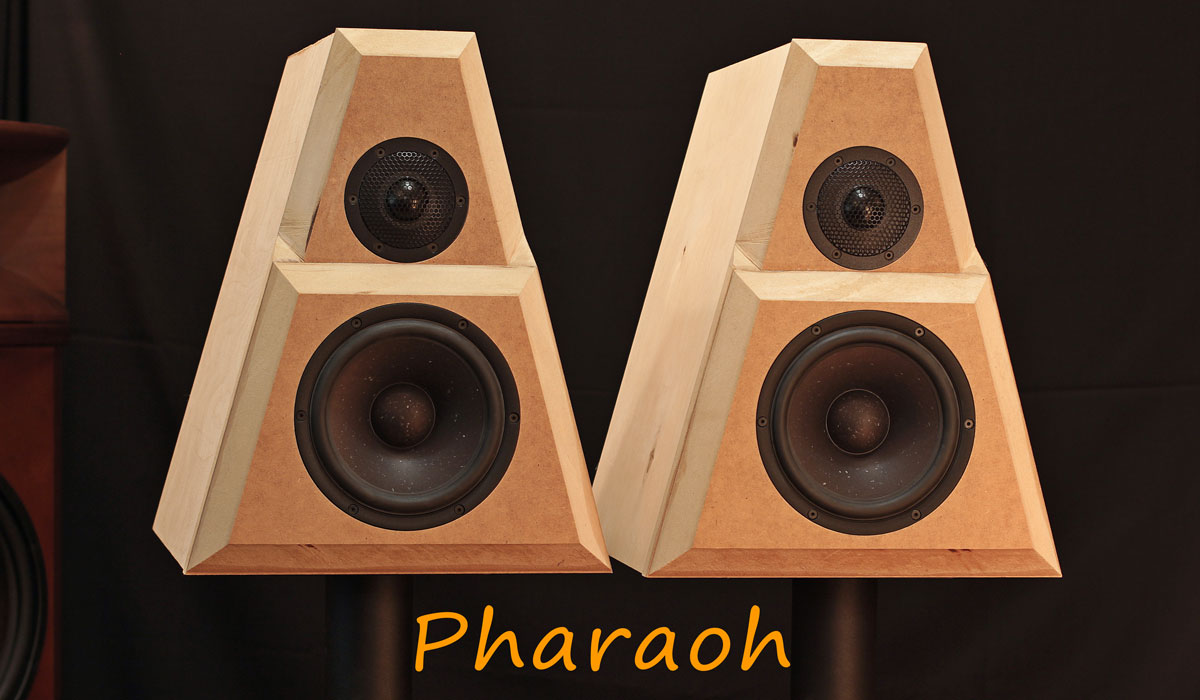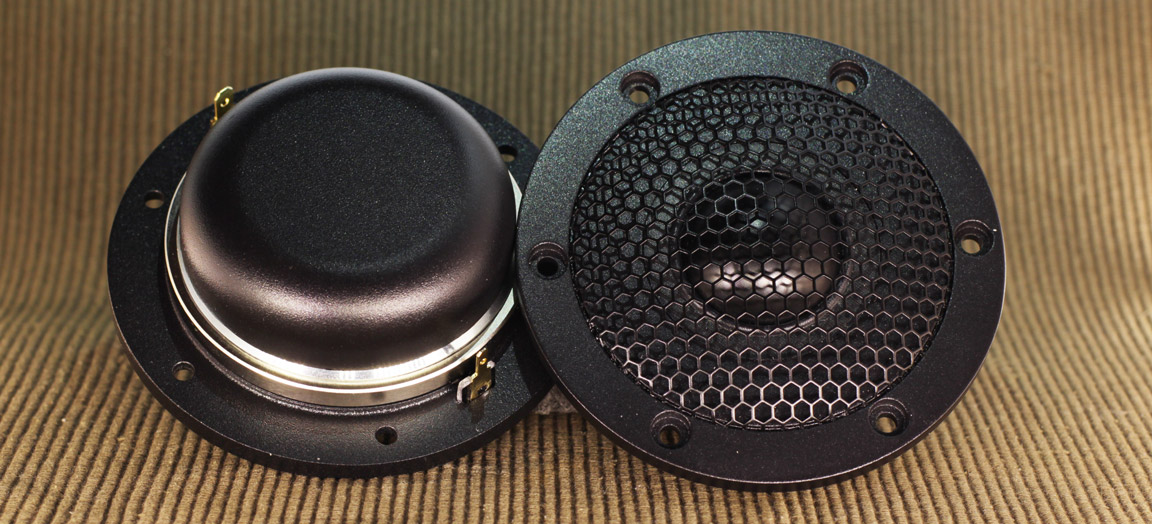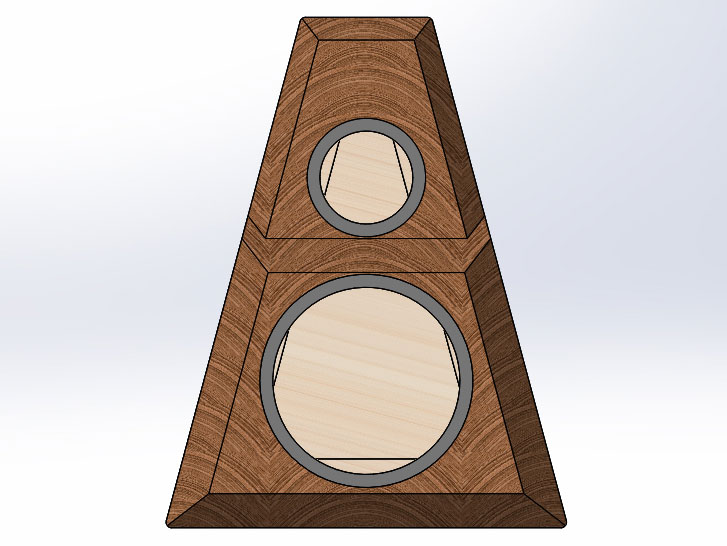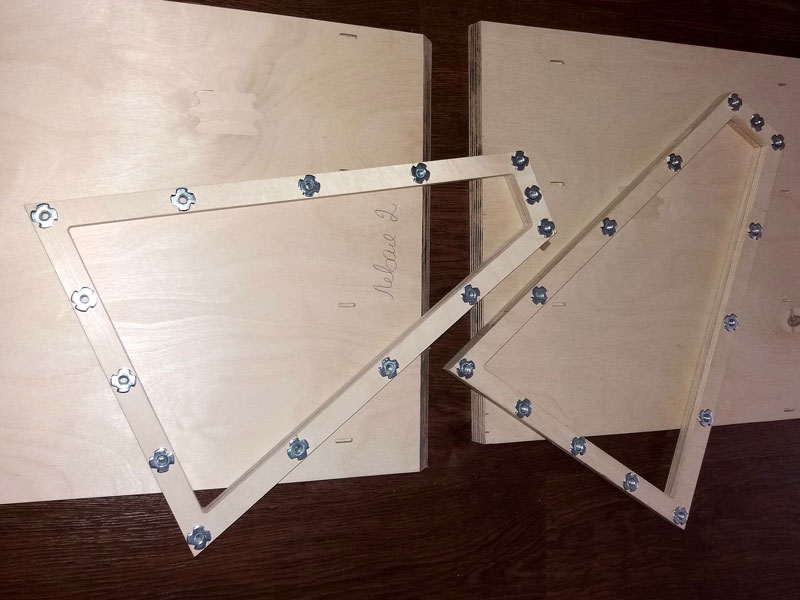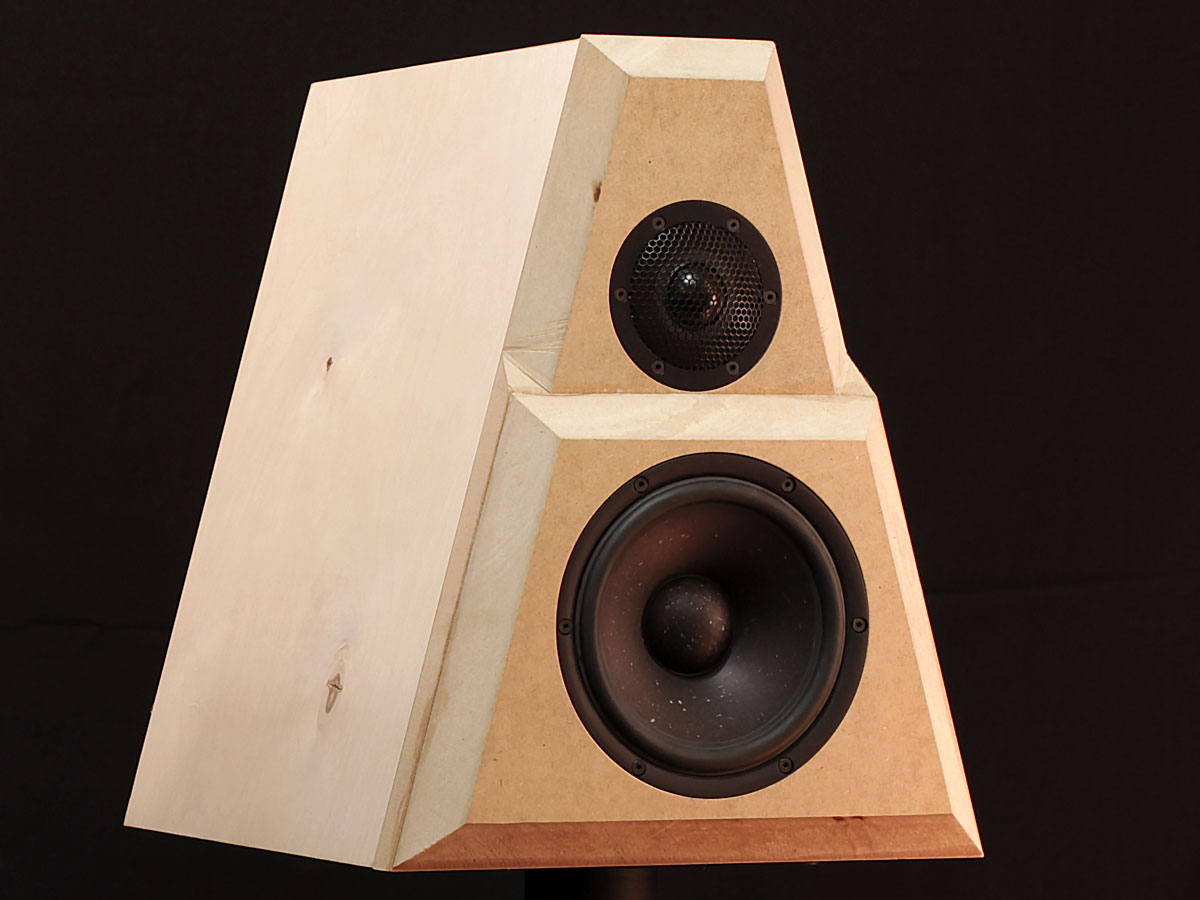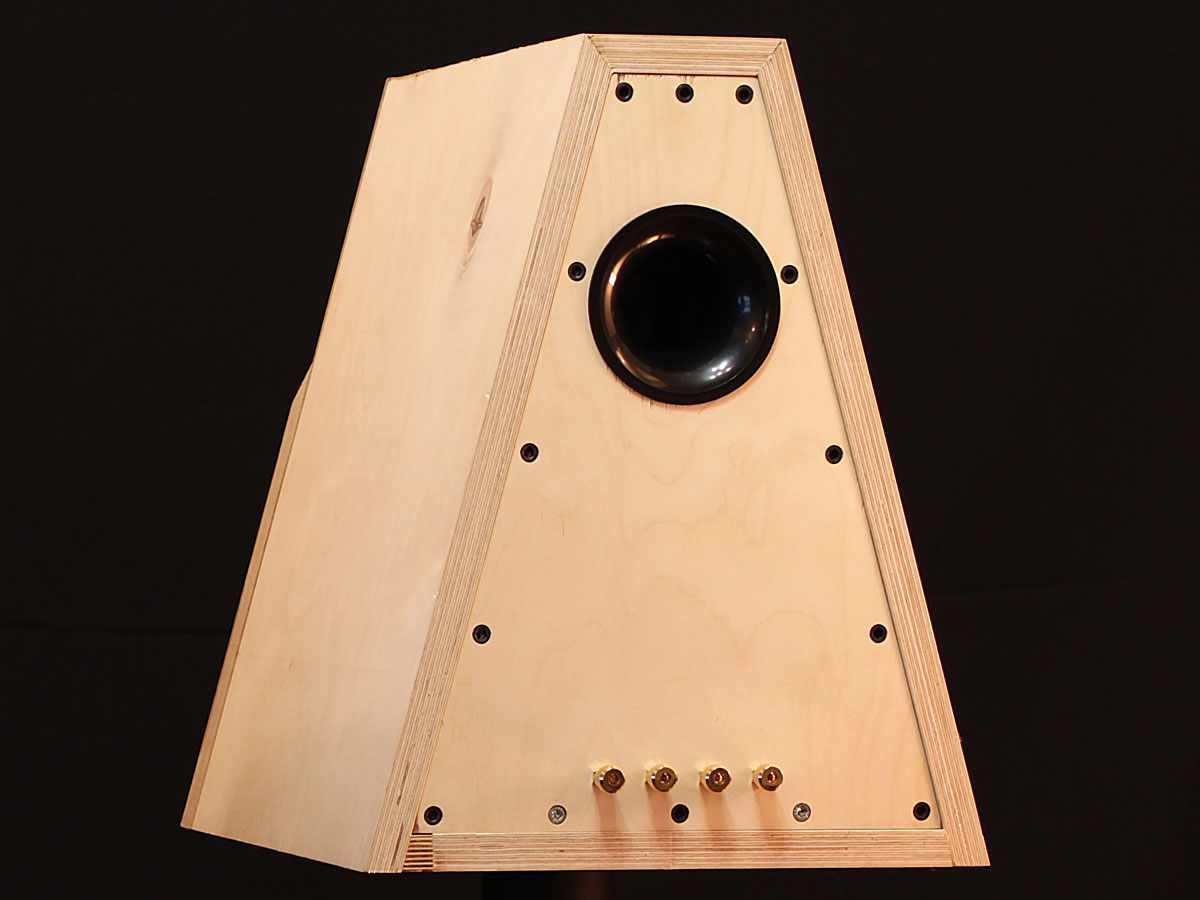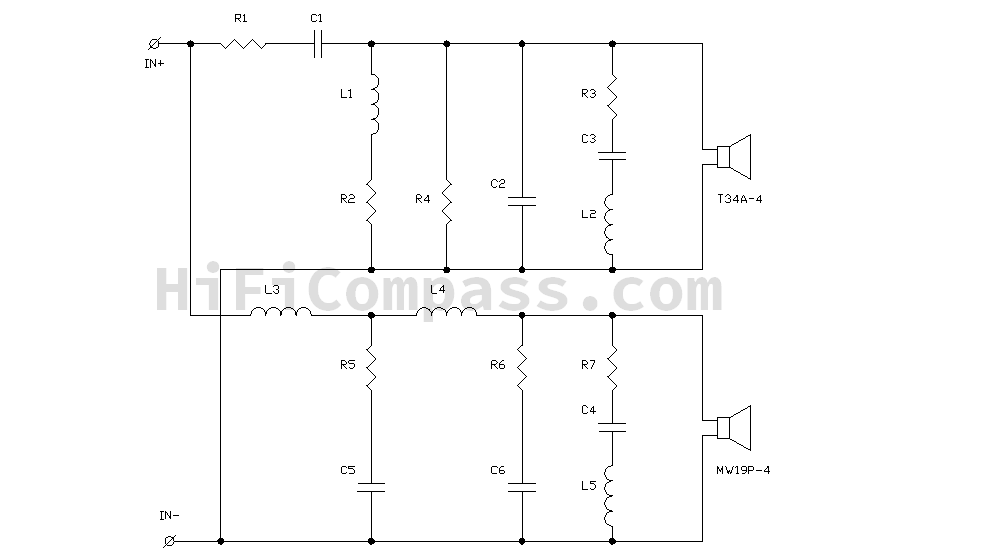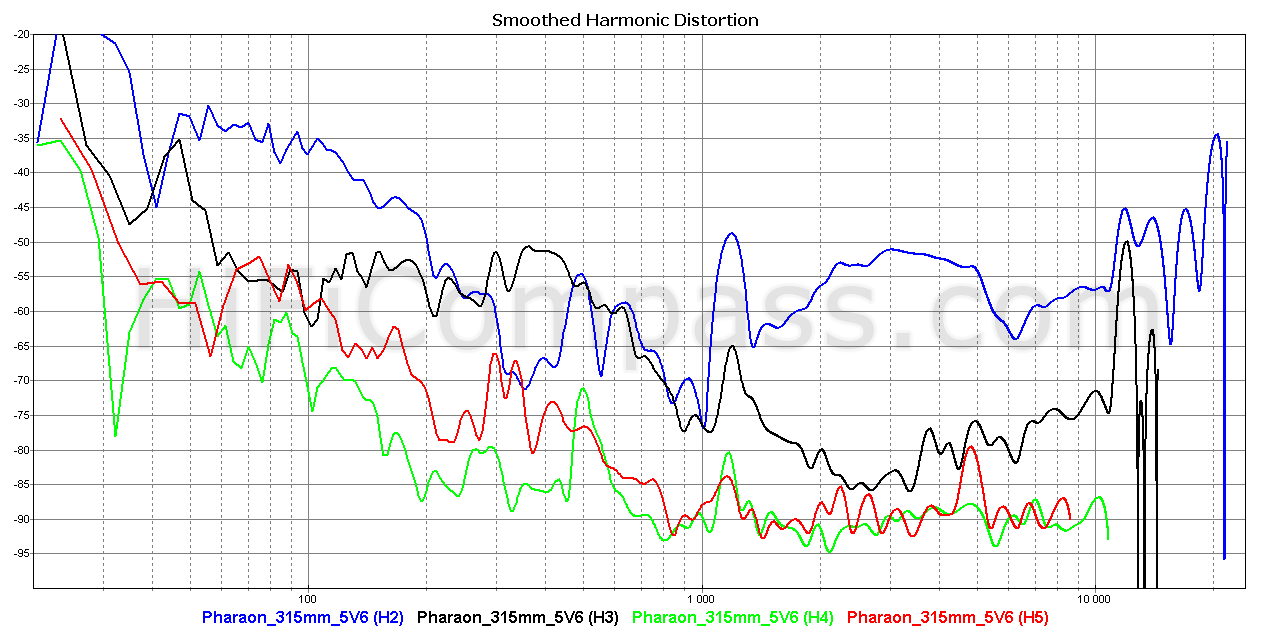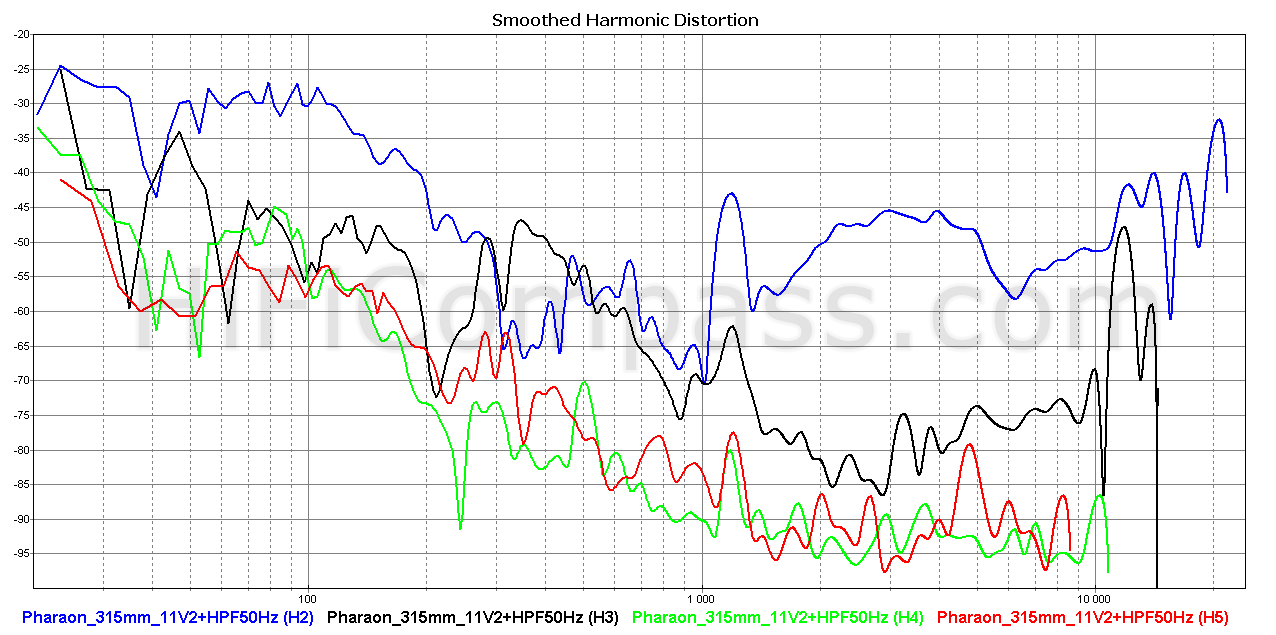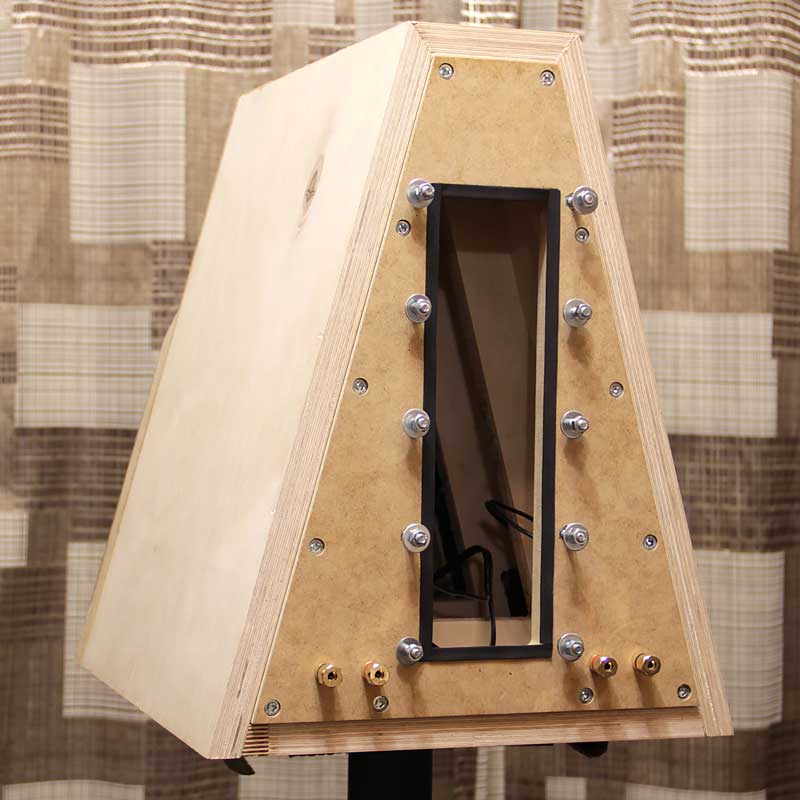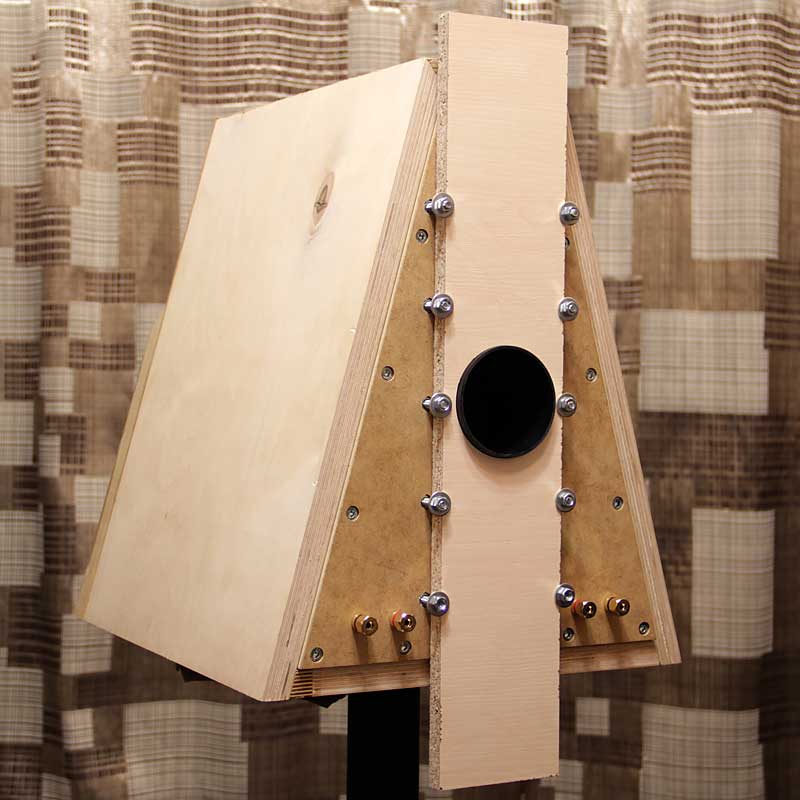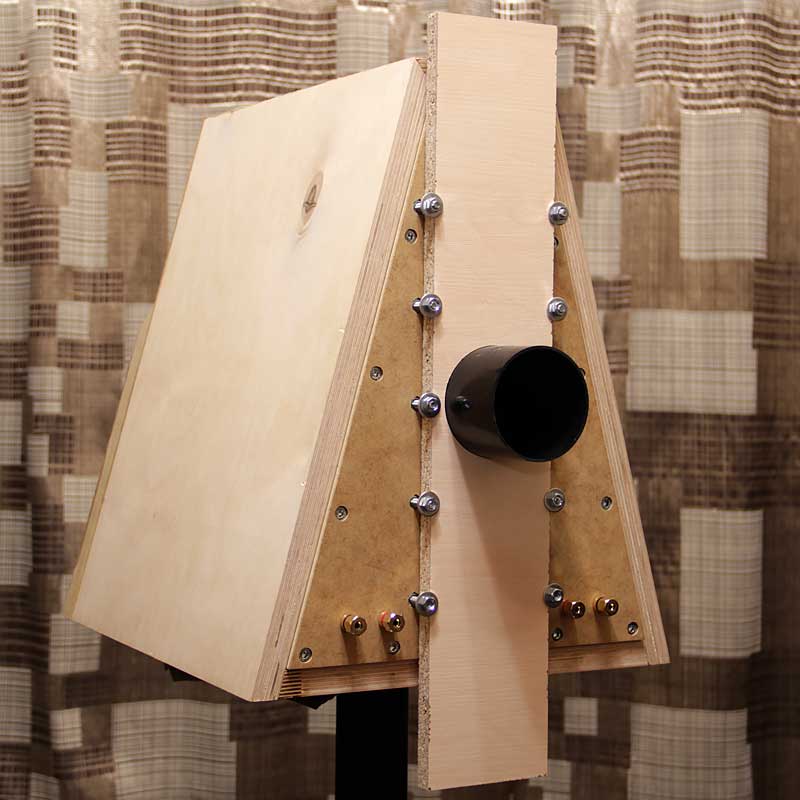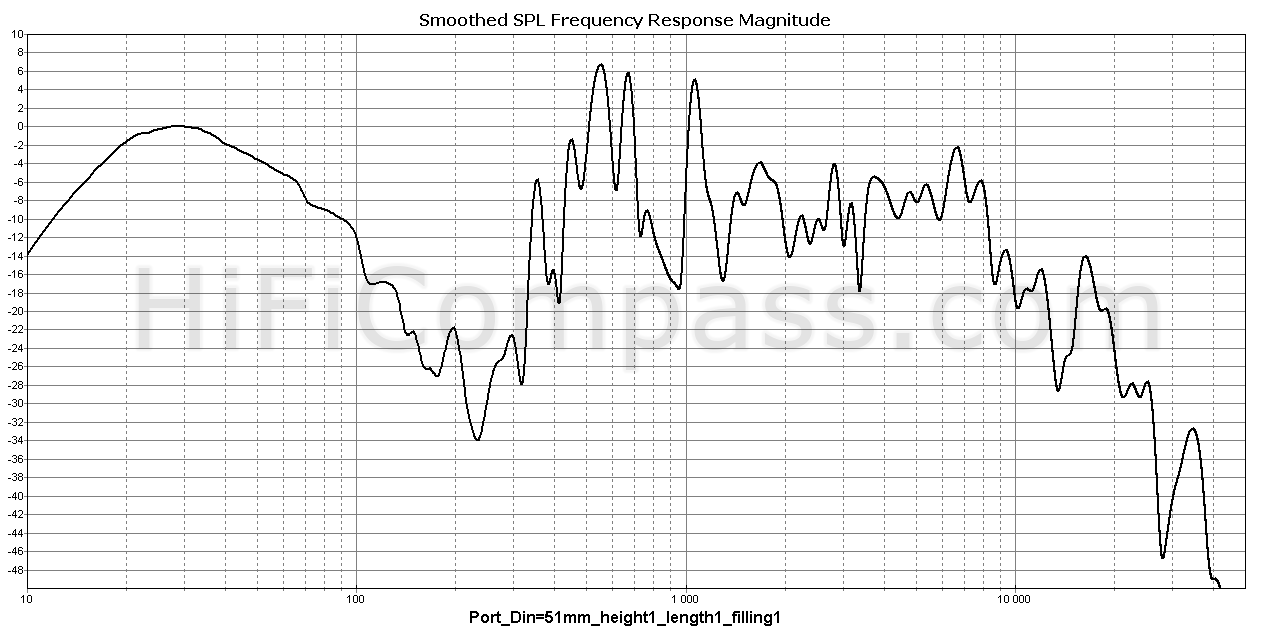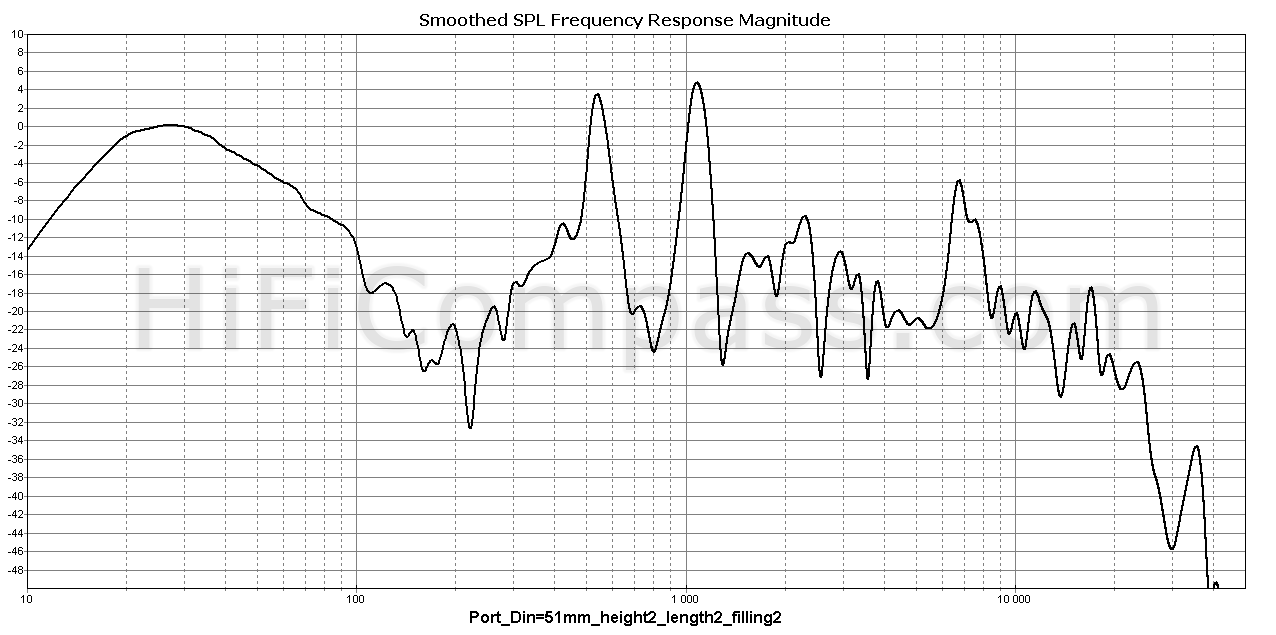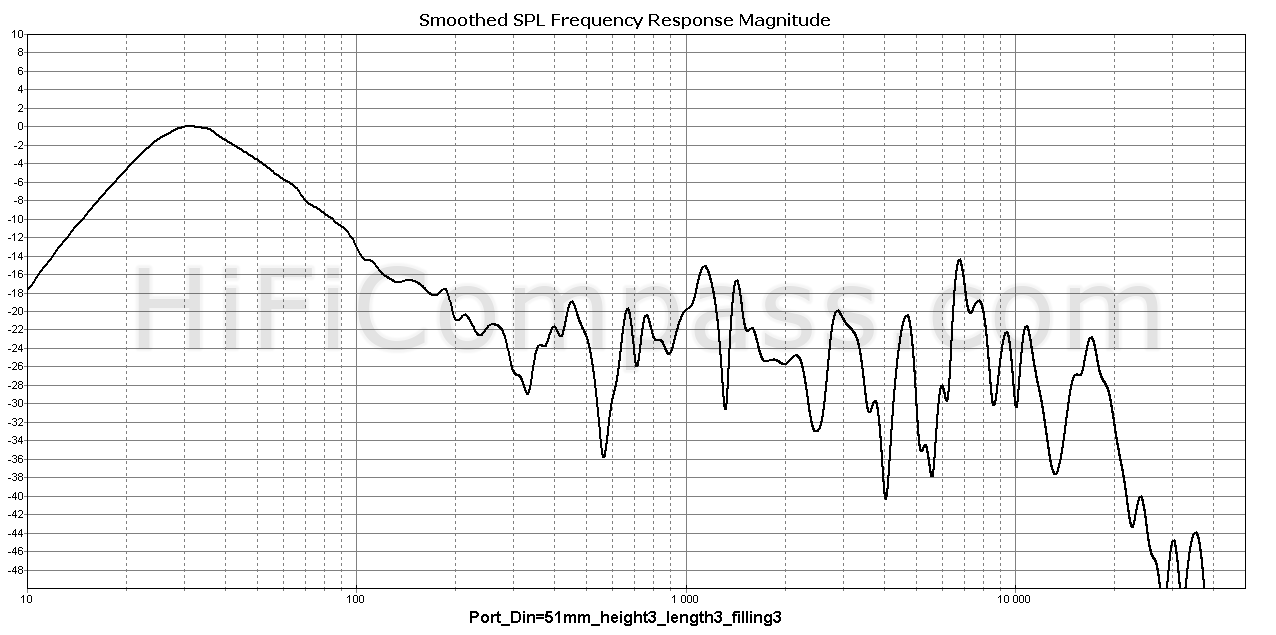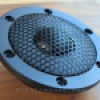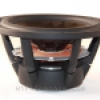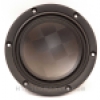HiFiCompass
Pharaoh
The idea
The idea of creation of a two-way loudspeaker with low crossover point, a serious bass potential and uncompromising frequency bands joining has not given rest to anyone for a long time. It would very nice to achieve the three-way speaker scale from a two-way one in a more compact size, while preserving the features of a two-way speaker as an excellent spatial sound picture and a lower cost. The bottom line is the vast majority of existing two-way speakers claiming bass capabilities use a 6" + 1" drivers configuration and has the crossover point around 2 - 2.5 kHz. This figure is far from being ideal and does not allow to get smooth joining of directivity patterns, because near crossover point begins the appreciable narrowing of spatial dispersion of the midwoofer radiation, while for the tweeter it is still very wide. It leads to the dip in the radiated power response and special sound character appears. Constructions having a 8"+1", 10"+1", 10"+1-1/3" topology provide often the good sound, but the sounding is very genre and those speakers can't be called universal. The design of such loudspeakers like the parable of the short blanket, you pull it on your face - your feet freeze. You want a lower and louder bass - you need a bigger midwoofer caliber, the bigger caliber, the more problems with midrange dispersion and you need to lower the crossover point frequency, but power handling and maximum linear excursion limitations of the tweeter hamper to that. Attempts to compensate for a small linear excursion with a larger membrane area, as in the case of the SEAS T35C002 tweeter, leads to a falling HF response and a narrowing of the sound dispersion. Therefore, all such designs are more or less compromised.
There is a fairly successful and popular technical solution to lower the crossover point by placing the tweeter in a waveguide and thus ensuring a large overload capability of the tweeter at the lower end of the operating frequency range while maintaining the smooth midwoofer to tweeter sound dispersion patterns joining. All is well, but such systems as a whole have the narrower radiation pattern and, hence, other spatial characteristics of the sound picture. This is neither good nor bad but is more a matter of taste preferences and integration into a specific listening room.
The obstacle to the development of the desired two-way loudspeaker was absence on the market of tweeters with the large linear voice coil excursion, wide sound dispersion and high power handling at the same time.
The situation changed with the appearance of the tweeter with a set of unique characteristics of BlieSMa T34A-4 at the beginning of 2018. That was a powerful stimulus for us in implementing the two-way speaker system with potential bass capabilities, wide sound dispersion and more even frequency response of the radiated power.
Choice of the loudspeaker drivers
So, the tweeter is already defined - BlieSMa T34A-4. The measurements confirmed the tweeter can safely withstand the lower operating frequency down to 1.3 kHz. Who can make him a worthy partner? It could be started with 8" midwoofer but immediately nothing came to our mind, as it is necessary that candidate has both good low end operation, very low distortions and a frequency response free from surprises up to 1.3kHz. We left this option for a later and decided to pick up some decent 6"-7" midwoofers, to test it in a project, look at the quality of the stitching with the tweeter and combination of drivers sound manners.
So, gentlemen-candidates:
Due to the fact that the project is commercial, when selecting the partner to the tweeter, the "price/quality" indicator was of no small importance, therefore, good midwoofers of the famous brands like Accuton, Audiotechnology and others dropped out of the circle of consideration.
- ScanSpeak 18W/4531G00 – a good midwoofer with very intrinsic soft paper sound, rejected due to doubts about the compatibility of the sound manner
- ScanSpeak 18WU/4731T00 – very good but pricey
- SEAS W18EX001 – good but pricey and a bit weak at the low end
- SEAS W18NX001 – good but pricey
- Satori MW19P-4 – a very good driver, membrane of hard paper with the adding of reinforcing fibers from Egyptian papyrus, large membrane area - 158cm2, an impressive linear excursion up to 6.8mm, very low distortion and the democratic price. The choice is made!
The only concern is how the outburst of distortions from the suspension resonance in the region of 1.2 kHz will manifest itself in the finished loudspeaker. But since the burst is relatively narrow and in this frequency region the signal at the midwoofer will decreased by almost 6-10dB in relation to the low band (due to the crossover slope + baffle-step compensation), that is, hope that it will not cause any problems. Looking ahead, we note that this is how it happened and no ear drilling artifacts due that resonance in the finished loudspeakers were found, which is also confirmed by the final measurements of the loudspeaker nonlinear distortions. It should be noted that in candidates also was being considered pairs SB Acoustics SB17CRC35-8 and SB17NBAC35-8 in MTM and 2.5 configurations. Moreover, the prototype of enclosure for these drivers was developed and even put into production, but for certain reasons it was decided to change priorities and at first to test the project on the Satori MW19P-4.
The SB17CRC35-8 and SB17NBAC35-8 are excellent speaker drivers. In terms of the "price/quality" ratio, in our opinion, today they simply do not have any competitors. Having approximately the same bass potential (referring to the pair SB17xxxx versus one MW19P) like the MW19P-4, their problematic suspension resonances are shifted higher up in frequency out of the targeted crossover point, they are absolutely clean in the passband and a pair of these speakers are able to handle more power. In addition, SB17NBAC35-8 is equipped with an aluminum alloy membrane, like the T34A-4 tweeter, so this combination promises to be fairly harmonious.
The construction
The project was conceived as a reference and we wanted to understand what the chosen speaker drivers are capable of, therefore, each element of the design was given special attention.
The loudspeaker enclosure has a trapezoidal cross-section, slightly resembling a pyramid, made of 21 mm thick plywood. This form allowed to reduce the number of internal parallel planes, in particular - the front and back walls only. The formation of internal standing waves is greatly reduced in such form and struggle with them is facilitated, which favorably affects the sound character. The tapering up front panel shape maintains a wide dispersion of the tweeter and reduces the parasitic effect of diffraction on the edges of the front panel.
Inside the enclosure there are vertically placed one-piece perimeter stiffeners with a step of 100mm in-between. Additionally, some plywood sheets are fixed by means the special damping substance 0.2-0.4mm thick in the critical places on the walls for vibrations absorbing. The step-shaped front panel of variable thickness from 25 to 50 mm serves for time-matching of the speakers drivers responses. The result is a sturdy and inert enclosure with very short response to tapping. Special attention was paid to the choice of port diameter and its placement in the enclosure, as well as the choice of type, quantity and location of the internal sound-absorbing material.
The port size choosing for a two-way loudspeaker is a much bigger challenge and compromise than for a three-way one. We have to consider several things at once:
- Kind of port exit - forward or backward. For the two-way designs, we believe that the port should out of the enclosure unambiguously back. Since what comes out of the port along with the useful low frequency signal contains a lot of extraneous midrange trash that severely spoils the sound. The rear location of the port creates some problems when installing the speakers near a wall, but, firstly, with this kind of loudspeaker placement there is an additional amplification of low frequencies so you can simply close the port hole, transformating the speaker LF design to the closed type, so reducing the excitation of parasitic room modes. Secondly, these loudspeakers are not at the performance level to put it against a wall and to lose all the advantages for which it was created.
- Positioning the port on the loudspeaker back wall. In principle, the port can be installed anywhere, but the degree of excitation and the level of parasitic midrange radiation from the port depends on its location. To determine the port optimal location we conducted a series of experiments (more than thirty), in which the main criterion was the radiation spectrum of the port for each specific case.
- The port tube diameter. The more diameter - better the behavior near the frequency of the main resonance of port-enclosure system, but higher the level of parasitic midrange radiation from it, as well as the it has more enriched spectrum. Therefore, the port tube diameter was chosen taking into account all of the above factors.
- Filling enclosure with a sound absorber is no less crucial, as the degree of its influence on the sound of a two-way loudspeaker is very difficult to overestimate. The problem is further aggravated by the fact that this influence is very difficult to control instrumentally and significant role is assigned to the auditory evaluation. Insufficiently filled enclosures will lead to the sound coloring in the midrange and a significant change in the spatial characteristics of the sound image in the direction of the false volume increasing of the virtual room wich the sound images are located in, and also to a decrease in the accuracy of localization. With overfilled enclosures everything happens exactly to the opposite direction in addition with a decreasing level in the low-frequency range.
The crossover
Since the targeted crossover frequency is sufficiently critical for the tweeter, there could be no questions of any first orders (here and in the following we mean acoustic orders, not electric ones). The second order also failed to implement. But the 3rd and 4th orders, Butterworth and Linkwitz-Riley were quite realizable. Several crossover versions with frequencies from 1.3kHz up to2 kHz, symmetrical and asymmetric frequency response slopes have been tested. It must be said that this is the case when they all sounded very differently. Nevertheless, it was decided to stop at the originally planned crossover frequency between 1.3 and 1.4 kHz and slightly asymmetric slopes in the stop bands, as this option gave the most tonally balanced, transparent and detailed sound, as well as the best off-axis behavior.
The advantages of the rather complicated front panel form and wide tweeter dispersion were not given free of charge - the diffraction humps on the frequency response were nevertheless revealed, but they were neatly processed in the crossover and only one notch chain was needed.
We want to note that the voicing of the loudspeakers as a whole took away the biggest part of the entire process of developing. For the first time in our practice we had to work with a tweeter with such a wide dispersion and huge operating frequency range. Its sound did not coincide with any of the patterns of sounds of tweeters being stored in our heads. Therefore, the habituation to such a wide and detailed sound character took some time.The task was to achieve the balance between analyticity and musicality at the same time, i.e. in the getting of harmonious combination of sound from two drivers with different membrane material. In addition, the unusually wide frequency range of the tweeter placed high demands on the tolerances of critical elements in the high frequency crossover section, since the smallest changes in the parameters affected immediately the entire band from 1.3kHz up to the high end of the range and was immediately noticeable by ear.This also applies to the quality of the components used. In this sense, the midwoofer crossover part was less demanding.
The measurements
On-axis frequency response in live room at distance m and voltage level 2.83V, smoothing 1/6 oct, time window- 500ms
HD2, HD3, HD4, HD5 frequency response at 315 mm distance
Impedance frequency response of the loudspeaker with opened and closed port
 The port is opened |
 The port is closed |
The sounding
Just note that the sound of the speaker is different from all those two-way systems with which we had to deal with. First, you do not immediately understand what is happening, since all the test records you know sound with newly opening details, which you simply did not notice before. The accents are placed in the spatial picture by the different way. The sound is very smooth, tonally balanced and, for all its analyticity, preserves musicality. The sound stage is very impressive - wide and deep with the preservation of the separation of virtual images. Magnificent transparency, localization is excellent too. Most likely, that all are attributes of wide dispersion and hard membranes of the tweeter and midwoofer. The lower register is full and quite impressive for the speakers of this size - this is the second moment that surprises the first time you listen. The transients and dynamics are just as a hurricane, you need to hear it at least once. The energy of the drum set on the famous track (Marilyn Mazur & Audun Kleive) - Drum Impro from the test disс The DALI CD vol.1 is just scary. After 15-20 minutes all the unusual sensations disappear and you just stick to the music, trying to make up for the lost feelings for many years, have forgotten that you were going to sit down for only 5 minutes to test the sound![]() .
.
But where are the shortcomings, you will ask? Is it really the ideal loudspeaker? No, there is not a such in the world for a while. Those listeners who like to push the air and feel the whole body massage need the bigger loudspeakers, of course. Audiophiles who are accustomed to the sound of soft and damped membranes also may not appraise the accurate, analytical, detailed sound with explosive dynamics. This is already a matter of taste.
The loudspeakers were developed for listening from a distance of 1.8 - 2.5 m and due to the very wide dispersion they are very sensitive to the acoustic properties of listening room, so be ready, if necessary, to work with the acoustic treatment of the room and with the arrangement of the speakers.
Specifications
- Frequency response – 30Hz - 24kHz
- Sensitivity – 86-88dB/2.83V*1meter
- Nominal impedance – 4 Ohm (minimum value - 3.4 Ohm/33Hz )
- LF design - ported
- Size (HxWxD) – 450mm*360mm*450mm
- Weight - 44 kg/pair
p.s. Pyramid like forms, the fibers of Egyptian papyrus and the sound that seizes you from the first minutes… Therefore – Pharaoh!
CONTACTS
- Ukraine
- (+380) 95 904 7827
- hificompass@gmail.com
LAST NEWS
-
27 Mar 2025
-
04 Mar 2025
-
25 Feb 2025
-
10 Feb 2025
